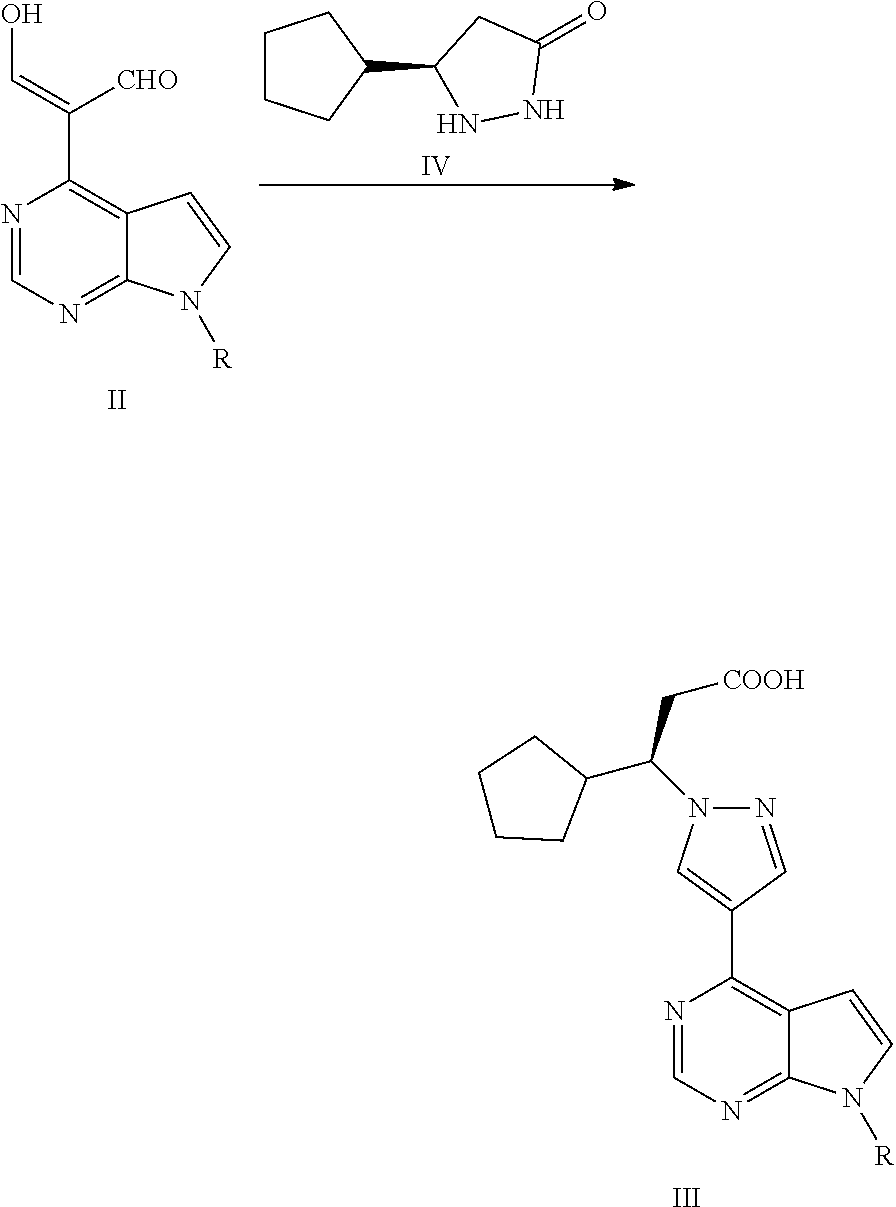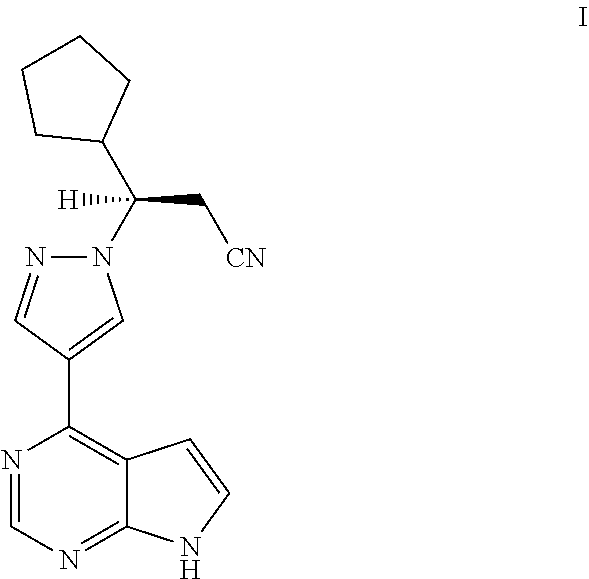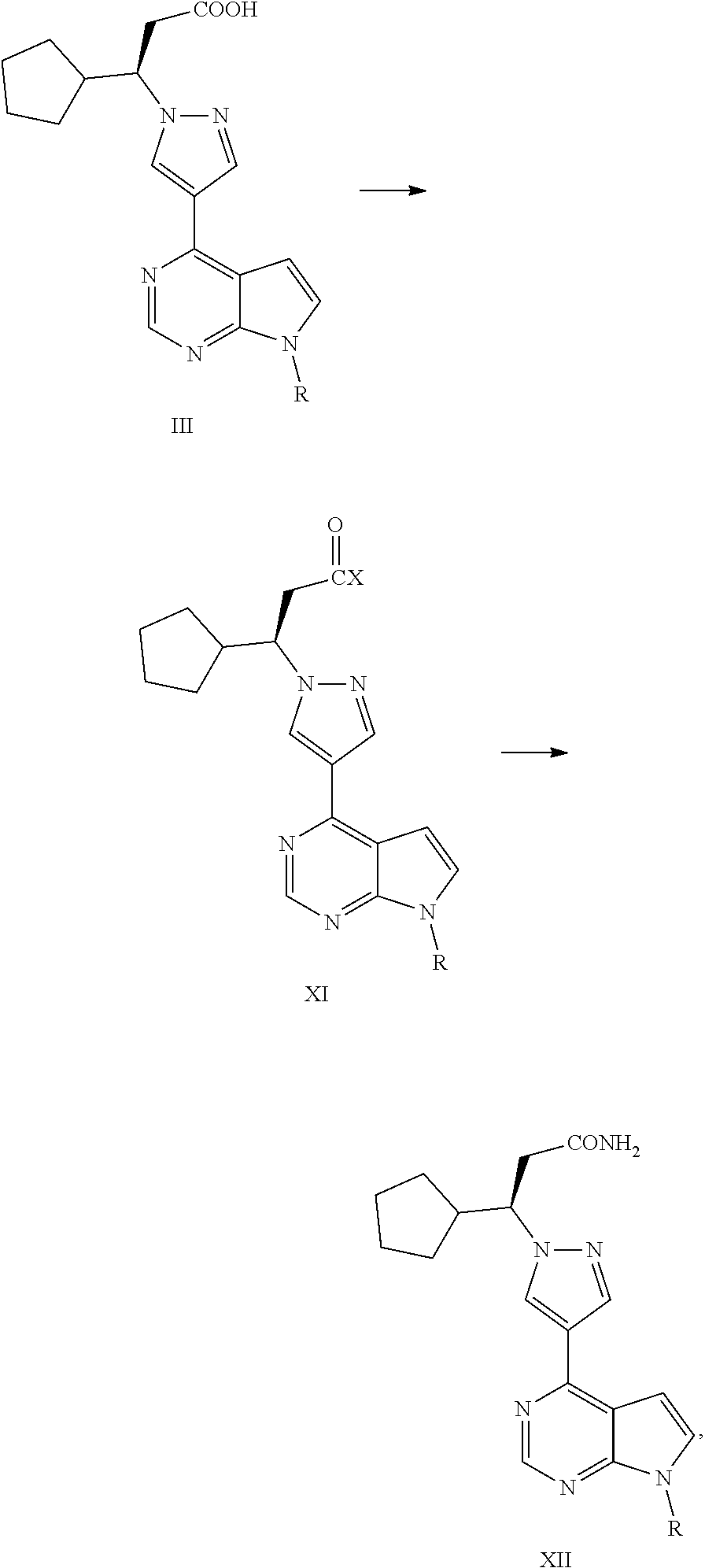Synthesis process of ruxolitinib
- Summary
- Abstract
- Description
- Claims
- Application Information
AI Technical Summary
Benefits of technology
Problems solved by technology
Method used
Image
Examples
example 1
(R)-5-cyclopentylpyrazolidin-3-one D-tartrate
[0229]
Step 1: 3-cyclopentyl Acrylic Acid
[0230]660 mL of cyclopentanecarbaldehyde and 500 g of malonic acid were added to 1 L of pyridine, and 13.4 mL of piperidine was added dropwise thereto and the resulting mixture was stirred at room temperature to react for 1 hour. Then the temperature was raised to 80° C. and the stirring was continued for 5 hours. After the reaction was completed, the resulting mixture was concentrated under reduced pressure to distill off the pyridine, and then 2.6 L of purified water was added thereto and the pH was adjusted to 2˜5 with concentrated hydrochloric acid. Then, the resulting mixture was extracted with ethyl acetate (1.7 L×3), and the organic layers were combined, and washed sequentially with 1 L of water and 1L of saturated brine. To the combined organic layer was added 4 L of 9% sodium hydroxide (1.3 L×3) and stirred, and the aqueous layers were combined and cooled down to 0˜5° C., and then concentra...
example 2
(R)-3-cyclopentyl-3-(4-(7H-pyrrolo[2,3-d]pyrimidin-4-yl)-1H-pyrazol-1-yl)propionitrile
[0240]
Step 1: 4-methyl-7H-pyrrolo[2,3-d]pyrimidine
[0241]150 g of 4-chloro-7H-pyrrolo[2,3-d]pyrimidine and 5.72 g of Pd(bppf)Cl2 were added to 1.5 L of tetrahydrofuran, stirred at room temperature for 0.5 hour, and then cooled down to below 0° C. To the resulting mixture was slowly added dropwise 850 mL of methylmagnesium bromide (3M dissolved in ether). After the addition was completed, the temperature was raised to 6065° C., and the resulting mixture reacted under reflux for 2 hours. Then, the temperature was lowered to below 0° C., and the reaction was quenched by slowly adding dropwise concentrated hydrochloric acid. After the addition was completed, 650 mL of purified water was added to the resulting mixture and stirred for 15 minutes, the phases were separated and the organic phase was discarded. The aqueous phase was adjusted to pH 6 with NaHCO3 and then suction-filtered, the filter cake was ...
example 3
4-chloro-7-((2-(trimethylsilyl)ethoxy)methyl)-7H-pyrrolo[2,3-d]pyrimidine
[0258]
[0259]450 g of 4-chloropyrrolo[2,3-d]pyrimidine was added to 3.6 L of DMF, and the temperature was lowered to −10° C.˜−20° C., and then 144 g of sodium hydride (60%) was added in batches. 586.0 g of 2-(trimethylsilyl)ethoxymethyl chloride was slowly added dropwise to the resulting mixture and stirred to react for 2 hours. After the reaction was completed, the reaction was quenched by dropwise adding 36 g of glacial acetic acid under stirring. Then, the reaction solution was poured into 14.4 L of purified water, and extracted with ethyl acetate, and then the organic layer was washed with saturated brine. The organic layer was concentrated under reduced pressure to remove the solvent, and the residue was purified by using 200300 mesh silica gel column chromatography to obtain 4-chloro-7-((2-(trimethylsilyl)ethoxy)methyl)-7H-pyrrolo[2,3-d]pyrimidine (808.2 g, 97.2%).
[0260]1H-NMR (500 MHz, DMSO-d6): δ=8.69 (s...
PUM
 Login to View More
Login to View More Abstract
Description
Claims
Application Information
 Login to View More
Login to View More - R&D
- Intellectual Property
- Life Sciences
- Materials
- Tech Scout
- Unparalleled Data Quality
- Higher Quality Content
- 60% Fewer Hallucinations
Browse by: Latest US Patents, China's latest patents, Technical Efficacy Thesaurus, Application Domain, Technology Topic, Popular Technical Reports.
© 2025 PatSnap. All rights reserved.Legal|Privacy policy|Modern Slavery Act Transparency Statement|Sitemap|About US| Contact US: help@patsnap.com



